 Facebook
Facebook
 X
X
 Instagram
Instagram
 TikTok
TikTok
 Youtube
Youtube
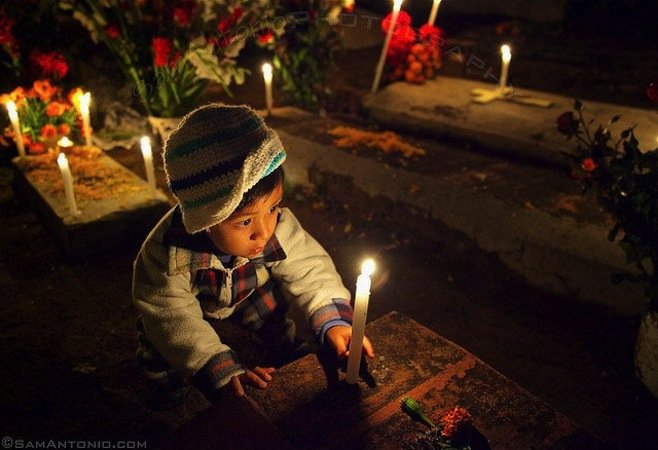
“The word death is not pronounced in New York, in Paris, in London, because it burns the lips. The Mexican, in contrast, is familiar with death, jokes about it, caresses it, sleeps with it, celebrates it, it is one of his favorite toys and his most steadfast love." ~ Octavio Paz (native of Mexico and winner of the 1990 Nobel Prize in literature)
Day of the Dead (El Día de los Muertos) is popular celebration throughout Latin America, especially in Mexico. I know zombies are the flavor of the month in today’s popular culture, but that's not what this celebration is about.
Most of the world is familiar with Halloween, since it's a huge commercial enterprise, especially in the States. While death is treated as something to be feared in Halloween tradition, the exact opposite holds true with Day of the Dead – death is looked upon as a source of celebration.
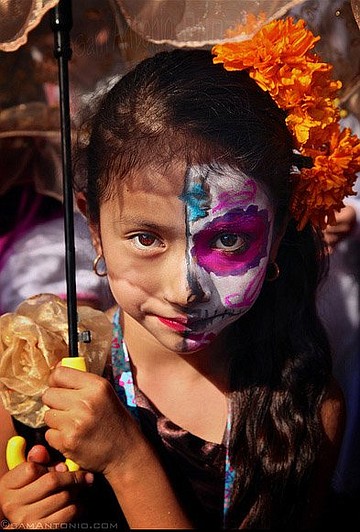
Day of the Dead is a national Mexican holiday. Family and friends get together to pray and remember their loved ones who have passed away. This is not a time of mourning, but a joyful celebration of life, food, friends and family.
Historically, the holiday is a syncretism of Pre-Hispanic and Spanish customs. Celebrations take place November 1–2, in connection with the Catholic holidays of All Saints' Day (November 1) and All Souls' Day (November 2).
In the beautiful colonial city of Oaxaca, Mexico, I was able to take in the sights, sounds and smiles of Day of the Dead.
On the days leading up to November 1 and 2 (along with celebrating Catholic holidays, on the 1st, people celebrate the lives of lost children, and on the 2nd they celebrate the spirits of adults), parties erupted throughout the streets of Oaxaca. This is another Day of the Dead tradition called comparsas, which is a carnival-like procession of people in costume, dancing and wild music accompanied by a banda band (think Mexican polka music).
The morning of October 31, young children dressed in costumes and, accompanied by their parents and teachers, paraded around town on their way to school. The children's comparsas circled around the town’s zocalo (main square), making for a vibrant public spectacle.
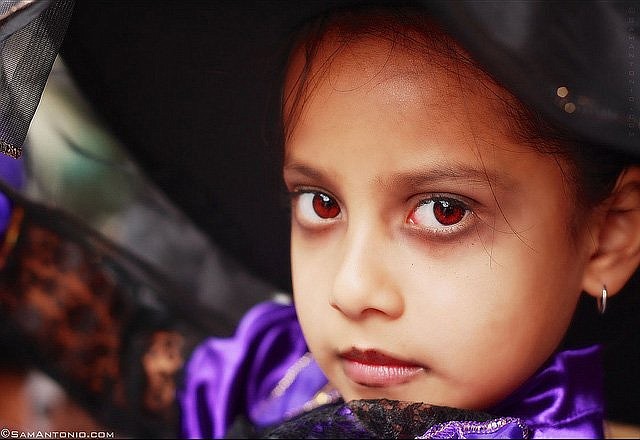
Photographing this procession was exciting, but technically difficult at times since there were fast-moving subjects in low light. Two key elements in street photography are preparedness and patience, and they surely came in handy that morning.
I remembered a quote from photojournalist Steve McCurry when he learned to watch and wait on life. “If you wait,” he realized, “people will forget your camera and the soul will drift up into view.”
I waited patiently for a “soul to drift up into my view” and I was rewarded with some beautiful travel portraits.
Just outside of Oaxaca City is Xoxocotlan Cemetery, where you can truly experience Day of the Dead festivities. The night of October 31, many local families begin their nightly vigils in this small cemetery – which is densely packed – as they sit by the tombs and wait for the return of the spirits.
The Mexican people believe that the spirits of the dead come back to visit the living on earth. Families gather in local cemeteries to celebrate their memory. They cover the gravesites with colorful flowers and thousands of candles. Several generations within a family sit around the gravesite and have a party for dead family members. They eat their favorite foods, drink mezcal (a liquor made from the agave cactus) and sing while the mariachis play the deceased’s favorite songs.
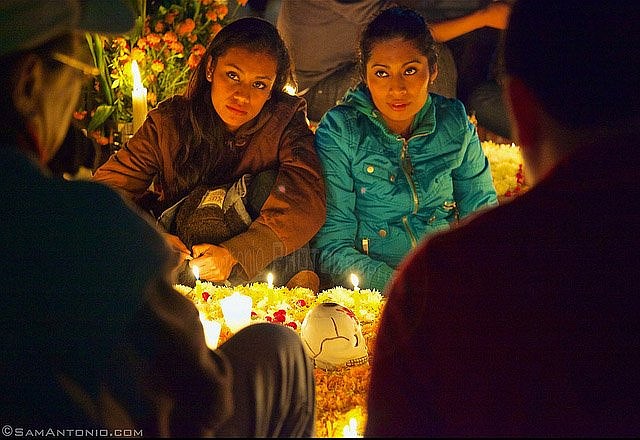
It was a surreal travel moment as I walked around the cemetery that was lit up by only the ambient light of the candles. I stood off in the distance observing a family before I approached them and asked permission to take a photo.
“¿Photo, por favor?”
Two gentlemen responded with a nod of approval; all the while, two young women were completely unaware of my presence since they had their complete attention on their cell phones and were texting as fast as their fingers would allow. Finally, the older gentlemen on the left started to speak of their deceased relatives, and the two young women quickly put away their cell phones and gave him their undivided attention.
That one brief moment for me embodied the essence of Day of the Dead with the portrayal of generations of families coming together as one to celebrate, learn and respect the spirits of their deceased relatives.
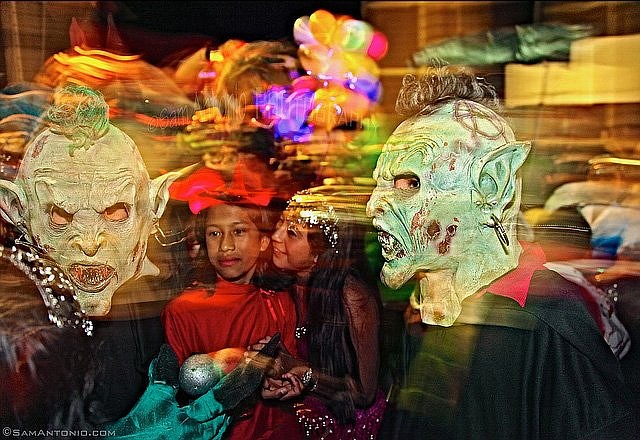
The next evening on November 1, I visited the small town of San Agustín Etla, about ten miles outside of Oaxaca City. The town is known for their wild celebrations, outrageous costumes and nonstop banda music. It was here that my five senses were duly assaulted by outrageous costumes, deafening music, enticing street food and a boisterous party atmosphere.
The evening’s festivities culminated in a friendly town rivalry in which the neighboring town paraded over to San Agustin’s central square to begin a face-to-face showdown. I knew the atmosphere was going to be unhinged when I saw a security squad of men with batons form a human barricade between the two towns.
For a good hour or so the two towns partied on their respective sides of the street, trying to outdo one another with flamboyant costumes, riotous dancing and piercing banda bands. Of course, I happened to be right in the middle of all of it.
After experiencing Day of the Dead celebrations in Mexico, Halloween will never be the same.


“The word death is not pronounced in New York, in Paris, in London, because it burns the lips. The Mexican, in contrast, is familiar with death, jokes about it, caresses it, sleeps with it, celebrates it, it is one of his favorite toys and his most steadfast love." ~ Octavio Paz (native of Mexico and winner of the 1990 Nobel Prize in literature)
Day of the Dead (El Día de los Muertos) is popular celebration throughout Latin America, especially in Mexico. I know zombies are the flavor of the month in today’s popular culture, but that's not what this celebration is about.
Most of the world is familiar with Halloween, since it's a huge commercial enterprise, especially in the States. While death is treated as something to be feared in Halloween tradition, the exact opposite holds true with Day of the Dead – death is looked upon as a source of celebration.

Day of the Dead is a national Mexican holiday. Family and friends get together to pray and remember their loved ones who have passed away. This is not a time of mourning, but a joyful celebration of life, food, friends and family.
Historically, the holiday is a syncretism of Pre-Hispanic and Spanish customs. Celebrations take place November 1–2, in connection with the Catholic holidays of All Saints' Day (November 1) and All Souls' Day (November 2).
In the beautiful colonial city of Oaxaca, Mexico, I was able to take in the sights, sounds and smiles of Day of the Dead.
On the days leading up to November 1 and 2 (along with celebrating Catholic holidays, on the 1st, people celebrate the lives of lost children, and on the 2nd they celebrate the spirits of adults), parties erupted throughout the streets of Oaxaca. This is another Day of the Dead tradition called comparsas, which is a carnival-like procession of people in costume, dancing and wild music accompanied by a banda band (think Mexican polka music).
The morning of October 31, young children dressed in costumes and, accompanied by their parents and teachers, paraded around town on their way to school. The children's comparsas circled around the town’s zocalo (main square), making for a vibrant public spectacle.

Photographing this procession was exciting, but technically difficult at times since there were fast-moving subjects in low light. Two key elements in street photography are preparedness and patience, and they surely came in handy that morning.
I remembered a quote from photojournalist Steve McCurry when he learned to watch and wait on life. “If you wait,” he realized, “people will forget your camera and the soul will drift up into view.”
I waited patiently for a “soul to drift up into my view” and I was rewarded with some beautiful travel portraits.
Just outside of Oaxaca City is Xoxocotlan Cemetery, where you can truly experience Day of the Dead festivities. The night of October 31, many local families begin their nightly vigils in this small cemetery – which is densely packed – as they sit by the tombs and wait for the return of the spirits.
The Mexican people believe that the spirits of the dead come back to visit the living on earth. Families gather in local cemeteries to celebrate their memory. They cover the gravesites with colorful flowers and thousands of candles. Several generations within a family sit around the gravesite and have a party for dead family members. They eat their favorite foods, drink mezcal (a liquor made from the agave cactus) and sing while the mariachis play the deceased’s favorite songs.

It was a surreal travel moment as I walked around the cemetery that was lit up by only the ambient light of the candles. I stood off in the distance observing a family before I approached them and asked permission to take a photo.
“¿Photo, por favor?”
Two gentlemen responded with a nod of approval; all the while, two young women were completely unaware of my presence since they had their complete attention on their cell phones and were texting as fast as their fingers would allow. Finally, the older gentlemen on the left started to speak of their deceased relatives, and the two young women quickly put away their cell phones and gave him their undivided attention.
That one brief moment for me embodied the essence of Day of the Dead with the portrayal of generations of families coming together as one to celebrate, learn and respect the spirits of their deceased relatives.

The next evening on November 1, I visited the small town of San Agustín Etla, about ten miles outside of Oaxaca City. The town is known for their wild celebrations, outrageous costumes and nonstop banda music. It was here that my five senses were duly assaulted by outrageous costumes, deafening music, enticing street food and a boisterous party atmosphere.
The evening’s festivities culminated in a friendly town rivalry in which the neighboring town paraded over to San Agustin’s central square to begin a face-to-face showdown. I knew the atmosphere was going to be unhinged when I saw a security squad of men with batons form a human barricade between the two towns.
For a good hour or so the two towns partied on their respective sides of the street, trying to outdo one another with flamboyant costumes, riotous dancing and piercing banda bands. Of course, I happened to be right in the middle of all of it.
After experiencing Day of the Dead celebrations in Mexico, Halloween will never be the same.
Comments